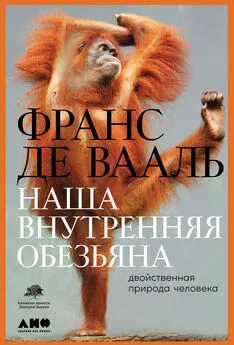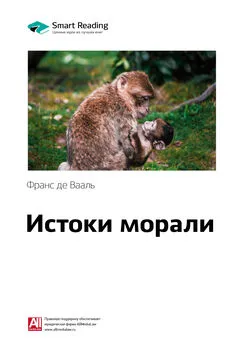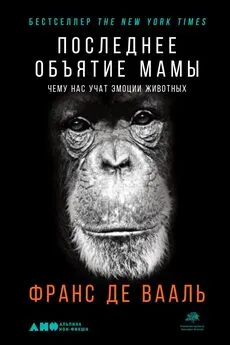Франс Вааль - Наша внутренняя обезьяна. Двойственная природа человека
- Название:Наша внутренняя обезьяна. Двойственная природа человека
- Автор:
- Жанр:
- Издательство:Литагент Альпина
- Год:2021
- Город:Москва
- ISBN:9785001394907
- Рейтинг:
- Избранное:Добавить в избранное
-
Отзывы:
-
Ваша оценка:
Франс Вааль - Наша внутренняя обезьяна. Двойственная природа человека краткое содержание
Де Вааль рассматривает четыре ключевые стороны нашей природы – стремление к власти, потребность в сексе, склонность к актам насилия и проявлениям доброты – и на основании многолетних наблюдений за человекообразными обезьянами доказывает, что все это в полной мере характерно и для них.
В своей работе он приводит аргументы в пользу представления о человеке как о социальном животном, «биполярной обезьяне», равно похожей на агрессивных, склонных к конкуренции шимпанзе и эмпатичных гедонистов-бонобо. Не игнорируя низменные стороны человеческой природы, де Вааль уделяет особое внимание ее положительным, нравственным проявлениям и тому, как две эти стороны сочетаются и дополняют друг друга, будучи одинаково важными для эволюции нашего вида и для выживания цивилизации в целом.
Наша внутренняя обезьяна. Двойственная природа человека - читать онлайн бесплатно ознакомительный отрывок
Интервал:
Закладка:
Montagu, A., Editor. (1968) Man and Aggression . London: Oxford University Press.
Morris, D. (1967) The Naked Ape . New York: McGraw-Hill.
Nakamichi, M. (1998) “Stick Throwing by Gorillas at the San Diego Wild Animal Park.” Folia primatologica 69: 291–295.
Nesse, R. M. (2001) “Natural Selection and the Capacity for Subjective Commitment.” In Evolution and the Capacity for Commitment , Nesse, R. M. (Ed.), pp. 1–44. New York: Russell Sage.
Nishida, T. (1968) “The Social Group of Wild Chimpanzees in the Mahali Mountains.” Primates 9: 167–224.
Parr, L. A., and de Waal, F. B. M. (1999) “Visual Kin Recognition in Chimpanzees.” Nature 399: 647–648.
Patterson, T. (1979) “The Behavior of a Group of Captive Pygmy Chimpanzees ( Pan Paniscus ).” Primates 20: 341–354.
Ridley, M. (1996) The Origins of Virtue . London: Viking. Ридли М. Происхождение альтруизма и добродетели. – М.: Эксмо-Пресс, 2016.
_____. (2002) The Cooperative Gene . New York: Free Press. Ридли М. Геном. – М.: Эксмо, 2015.
Schwab, K. (February 24, 2003) “Capitalism Must Develop More of a Conscience.” Newsweek .
Smith, A. (1937 [1759]) A Theory of Moral Sentiments . New York: Modern Library. Смит А. Теория нравственных чувств. – М.: Республика, 1997.
Sober, E., and Wilson, D. S. (1998) Unto Others: The Evolution and Psychology of Unselfish Behavior . Cambridge, MA: Harvard University Press.
Taylor, S. (2002) The Tending Instinct . New York: Times Books.
Tratz, E. P., and Heck, H. (1954) “Der Afrikanische Anthropoide ‘Bonobo,’ eine Neue Menschenaffengattung.” Säugetierkundliche Mitteilungen 2: 97–101.
Wildman, D. E., Uddin, M., Liu, G., Grossman, L. I., and Goodman, M. (2003) “Implications of Natural Selection in Shaping 99.4 % Nonsynonymous DNA Identity Between Humans and Chimpanzees: Enlarging Genus Homo.” Proceedings of the National Academy of Sciences 100: 7181–7188.
Williams, G. C. (1988) Reply to comments on “Huxley’s Evolution and Ethics in Sociobiological Perspective.” Zygon 23: 437–438.
Wilson, E. O. (1978) On Human Nature . Cambridge, MA: Harvard University Press. Уилсон Э. О природе человека. – М.: Кучково поле, 2015.
Wrangham, R. W., and Peterson, D. (1996) Demonic Males: Apes and the Evolution of Human Aggression . Boston: Houghton Mifflin.
Wright, R. (1994) The Moral Animal: The New Science of Evolutionary Psychology . New York: Pantheon. Райт Р. Моральное животное. – М.: АСТ, 2020.
Yerkes, R. M. (1925) Almost Human . New York: Century.
Zihlman, A. L. (1984) “Body Build and Tissue Composition in Pan Pansicus and Pan Troglodytes , with Comparisons to Other Hominoids.” In The Pygmy Chimpanzee , Susman, R. L. (Ed.), pp. 179–200. New York: Plenum.
Zihlman, A. L., Cronin, J. E., Cramer, D. L., and Sarich, V. M. (1978) “Pygmy Chimpanzee as a Possible Prototype for the Common Ancestor of Humans, Chimpanzees, and Gorillas.” Nature 275: 744–746.
Adang, O. (1999) De Machtigste Chimpansee van Nederland: Leven en Dood in een Mensapengemeenschap . Amsterdam: Nieuwezijds.
Boehm, C. (1993) “Egalitarian Behavior and Reverse Dominance Hierarchy.” Current Anthropology 34: 227–254.
_____. (1994) “Pacifying Interventions at Arnhem Zoo and Gombe.” In Chimpanzee Cultures , Wrangham, R. W., McGrew, W. C., de Waal, F. B. M., and Heltne, P. (Eds.), pp. 211–226. Cambridge, MA: Harvard University Press.
_____. (1999) Hierarchy in the Forest: The Evolution of Egalitarian Behavior. Cambridge, MA: Harvard University Press.
de Waal, F. B. M. (1984) “Sex-Differences in the Formation of Coalitions Among Chimpanzees.” Ethology & Sociobiology 5: 239–255.
_____. (1994) “The Chimpanzee’s Adaptive Potential: A Comparison of Social Life Under Captive and Wild Conditions.” In Chimpanzee Cultures , Wrangham, R. W., McGrew, W. C., de Waal, F. B. M., and Heltne, P. (Eds.), pp. 243–260. Cam- bridge, MA: Harvard University Press.
_____. (1997) Bonobo: The Forgotten Ape , with photographs by Frans Lanting. Berkeley, CA: University of California Press.
_____. (1998 [1982]) Chimpanzee Politics: Power and Sex Among Apes . Revised edition. Baltimore, MD: Johns Hopkins University Press. Де Валь Ф. Политика у шимпанзе. Власть и секс у приматов. – М.: ИД ВШЭ, 2020.
de Waal, F. B. M. and L. M. Luttrell. (1988) “Mechanisms of Social Reciprocity in Three Primate Species: Symmetrical Relationship Characteristics or Cognition?” Ethology & Sociobiology 9: 101–118.
_____. (1989) “Toward a Comparative Socioecology of the Genus Macaca: Different Dominance Styles in Rhesus and Stumptail Monkeys.” American Journal of Primatology 19: 83–109.
Doran, D. M., Jungers, W. L., Sugiyama, Y., Fleagle, J. G., and Heesy, C. P. (2002) “Multivariate and Phylogenetic Approaches to Understanding Chimpanzee and Bonobo Behavioral Diversity.” In Behavioural Diversity in Chimpanzees and Bonobos , Boesch, C., Hohmann, G., and Marchant, L. F. (Eds.), pp. 14–34. Cambridge: Cambridge University Press.
Dowd, M. (April 10, 2002) “The Baby Bust.” The New York Times .
Furuichi, T. (1989) “Social Interactions and the Life History of Female Pan Paniscus in Wamba, Zaire.” International Journal of Primatology 10: 173–197.
_____. (1992) “Dominance Status of Wild Bonobos at Wamba, Zaire.” XIVth Congress of the International Primatological Society, Strasbourg, France.
_____. (1997) “Agonistic Interactions and Matrifocal Dominance Rank of Wild Bonobos at Wamba.” International Journal of Primatology 18: 855–875.
Gamson, W. (1961) “A Theory of Coalition Formation.” American Sociological Review 26: 373–382.
Goodall, J. (1992) “Unusual Violence in the Overthrow of an Alpha Male Chimpanzee at Gombe.” In Topics in Primatology, Volume 1, Human Origins , Nishida, T., McGrew, W. C., Marler, P., Pickford, M., and de Waal, F. B. M. (Eds.), pp. 131–142. University of Tokyo Press, Tokyo.
Grady, M. F., and McGuire, M. T. (1999) “The Nature of Constitutions.” Journal of Bioeconomics 1: 227–240.
Gregory, S. W., and Webster, S. (1996) “A Nonverbal Signal in Voices of Interview Partners Effectively Predicts Communication Accommodation and Social Status Perceptions.” Journal of Personality and Social Psycholology 70: 1231–1240.
Gregory, S. W., and Gallagher, T. J. (2002) “Spectral Analysis of Candidates’ Nonverbal Vocal Communication: Predicting U. S. Presidential Election Outcomes.” Social Psychology Quarterly 65: 298–308.
Hobbes, T. (1991 [1651]) Leviathan . Cambridge: Cambridge University Press. Гоббс Т. Левиафан, или Материя, форма и власть государства церковного и гражданского. – М.: Соцэкгиз, 1936; последнее издание: Гоббс Т. Левиафан. – СПб.: Азбука, 2020.
Hohmann, G., and Fruth, B. (1996) “Food Sharing and Status in Unprovisioned Bonobos.” In Food and the Status Quest , Wiessner, P., and Schiefenhövel, W. (Eds.), pp. 47–67. Providence, RI: Berghahn.
Kano, T. (1996) “Male Rank Order and Copulation Rate in a Unit-Group of Bonobos at Wamba, Zaïre.” In Great Ape Societies , McGrew, W. C., Marchant, L. F., and Nishida, T. (Eds.), pp. 135–145. Cambridge: Cambridge University Press.
Kano, T. (1998) Comments on C. B. Stanford. Current Anthropology 39: 410–411.
Kawanaka, K. (1984) “Association, Ranging, and the Social Unit in Chimpanzees of the Mahale Mountains, Tanzania.” International Journal of Primatology 5: 411–434.
Konner, M. (2002) “Some Obstacles to Altruism.” In Altruistic Love: Science, Philosophy, and Religion in Dialogue , Post, S. G., et al. (Eds.), pp 192–211. Oxford: Oxford University Press.
Lee, P. C. (1997) “The Meanings of Weaning: Growth, Lactation and Life History.” Evolutionary Anthropology 5: 87–96.
Lee, R. B. (1979) The!Kung San: Men, Women, and Work in a Foraging Society. Cambridge: Cambridge University Press.
Mulder, M. (1979) Omgaan met Macht . Amsterdam: Elsevier.
Nishida, T. (1983) “Alpha Status and Agonistic Alliances in Wild Chimpanzees.” Primates 24: 318–336.
Nishida, T., and Hosaka, K. (1996) “Coalition Strategies Among Adult Male Chimpanzees of the Mahale Mountains, Tanzania.” In Great Ape Societies , McGrew, W. C., Marchant, L. F., and Nishida, T. (Eds.), pp. 114–134. Cambridge: Cambridge University Press.
Parish, A. R. (1993) “Sex and Food Control in the ‘Uncommon Chimpanzee’: How Bonobo Females Overcome a Phylogenetic Legacy of Male Dominance.” Ethology & Sociobiology 15: 157–179.
Parish, A. R., and de Waal, F. B. M. (2000) “The Other ‘Closest Living Relative’: How Bonobos Challenge Traditional Assumptions About Females, Dominance, Intra- and Inter-Sexual Interactions, and Hominid Evolution.” In Evolutionary Perspectives on Human Reproductive Behavior , LeCroy, D., and Moller, P. (Eds.), pp. 97–103. Annals of the New York Academy of Sciences 907.
Riss, D., and Goodall, J. (1977) “The Recent Rise to the Alpha-Rank in a Population of Free-Ranging Chimpanzees.” Folia primatologica 27: 134–151.
Roy, R., and Benenson, J. F. (2002) “Sex and Contextual Effects on Children’s Use of Interference Competition.” Developmental Psychology 38: 306–312.
Sacks, O. (1985) The Man who Mistook His Wife for a Hat. London: Picador. Сакс О. Человек, который принял жену за шляпу, и другие истории из врачебной практики. – М.: АСТ, 2015.
Sapolsky, R. M. (1994) Why Zebras Don’t Get Ulcers . New York: Freeman. Сапольски Р. Почему у зебр не бывает инфаркта. Психология стресса. – СПб.: Питер, 2020.
Schama, S. (1987) The Embarrassment of Riches: An Interpretation of Dutch Culture in the Golden Age. New York: Knopf.
Schjelderup-Ebbe, T. (1922) “Beiträge zur Sozialpsychologie des Haushuhns.” Zeitschrift für Psychologie 88: 225–252.
Sherif, M. (1966) In Common Predicament: Social Psychology of Intergroup Conflict and Cooperation. Boston: Houghton Mifflin.
Stanford, C. B. (1998) “The Social Behavior of Chimpanzees and Bonobos.” Current Anthropology 39: 399–407.
Strier, K. B. (1992) “Causes and Consequences of Nonaggression in the WoollySpider Monkey, or Muriqui.” In Aggression and Peacefulness in Humans and Other Primates , Silverberg, J., and Gray, J. P. (Eds.), pp. 100–116. New York: Oxford University Press.
Thierry, B. (1986) “A Comparative Study of Aggression and Response to Aggression in Three Species of Macaque.” In Primate Ontogeny, Cognition and Social Behavior , Else, J. G., and Lee, P. C. (Eds.), pp. 307–313. Cambridge: Cambridge University Press.
Читать дальшеИнтервал:
Закладка:




![Франс Вааль - Последнее объятие Мамы [litres]](/books/1075030/frans-vaal-poslednee-obyatie-mamy-litres.webp)





